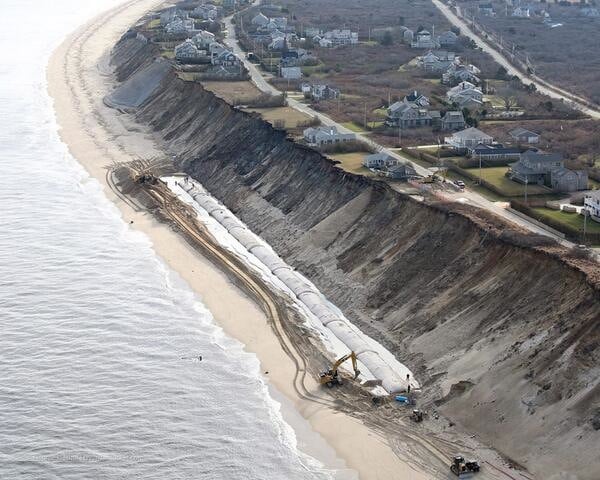The controversial geotube erosion control project at the Sconset bluff was ordered to be removed Wednesday after the Nantucket Conservation Commission dressed down the Sconset Beach Preservation Fund in stunning fashion for failing to comply with its permit for the pilot project.
The 900-foot sand-filled geotube has been installed at the bottom of the bluff on the east end of Nantucket for nearly eight years. The $10 million project is the Sconset Beach Preservation Fund’s (SBPF) most recent bid to protect the homes perched precariously along Baxter Road at the edge of the bluff from erosion.
 But on a 6-1 vote Wednesday evening, the Conservation Commission determined that the SBPF had failed to comply with its permit for the project, specifically the requirement for a certain amount of sand that should have been dumped annually over the geotube to replenish the area, and that the erosion control installation must be removed.
But on a 6-1 vote Wednesday evening, the Conservation Commission determined that the SBPF had failed to comply with its permit for the project, specifically the requirement for a certain amount of sand that should have been dumped annually over the geotube to replenish the area, and that the erosion control installation must be removed.
In an hour-long tongue-lashing during a virtual meeting held on Zoom, the members of the Conservation Commission vigorously criticized the SBPF’s failure to provide the amount of sand contributions specified in the permit, its responsiveness, and willingness to act in good faith.
“Frankly, they haven’t provided any excuse for the shortfalls, and the principals of SBPF have publicly stated that despite the fact the agreement was signed by SBPF, somehow it was understood by them the sand contributions would not be enforced as written,” said Maureen Phillips. “That’s a novel way of looking at written agreements. I do not believe there’s any weight or value to be given to that position. It shows a lack of respect for the Mass DEP (Department of Environmental Protection) who also signed off on the sand requirements, the town, and the Conservation Commission itself. There’s a long history of actions and disrespect.”
According to its permit, the SBPF is required to dump at least 22 cubic yards of sand per linear foot every year over the top of the project site to replenish the areas around the geotube installation and prevent increased erosion at either end. The deficit of sand as of January 2021 now stands at 26,637 cubic yards of sand that were not delivered to the project site.
At the meeting, SBPF President Josh Posner indicated the group could be amenable to to a plan that would bring it into compliance with its permit, but continued to maintain that the amount of sand mitigation it called for was excessive and beyond the statewide standard for similar projects.
“We can only protect the pilot project in the context of a long term plan that’s feasible and sustainable,” Posner said during the meeting. “Our No. 1 priority is to be in compliance and working on a project cooperatively with the town that is in compliance. We’d be very happy to bring this pilot project into compliance with a reasonable plan in the context of a sustainable system. That’s all we can do.”
Yet the chair of the Conservation Commission, Ashley Erisman, was not convinced, and pulled no punches in her assessment: “If this was my project, and I knew it was so out of compliance, it would be an urgent need to figure out a plan. I worry that you guys continue to drag your feet. If this was the first issue, it would be different. But we’re on enforcement No. 5 at this point, which is completely unacceptable.”
What happens now? The town’s Natural Resources Director Jeff Carlson said the commission staff would draft an order of conditions for the removal of the geotube that must be reviewed and voted on by the commission members. Once that happens, a 21-day appeal period begins in which SBPF can choose to bring the case to Nantucket Superior Court. If there is no appeal or that effort is unsuccessful, only then will the geotube be removed with funds already set aside in escrow by SBPF for that purpose, which was part of the licensing for the project.
“They are obligated as the permit holder to do that work,” Carlson said. “The licensing through the Select Board had measures in there for performance bonding in escrow to pay for removal.”
Contacted yesterday for his reaction to the Conservation Commission’s vote, Posner said the SBPF is weighing its options with regard to an appeal, and asked rhetorically “Is this really how Nantucket is going to respond to the crescendo of challenges to our island’s coastline?”
Posner added “As part of a joint agreement with the town, once the pilot proved successful, the clear intention was to expand the project to protect additional homes, the very ones providing the private funding to cover all costs, now over $10 million. The ConCom has done everything possible to make the project infeasible – structurally and financially. This includes continuing to require excessive amounts of sand mitigation originally included in the license for the project, a number that is nearly twice what is normally required and that monitoring data has long since proven unnecessary to meet the goal of protecting nearby beaches. The project itself has proven itself to be a success – it works as a method to prevent erosion, preserve historic homes and town infrastructure (Baxter Road), access to Sankaty Light House. There has been no harm Sconset Beach or other nearby beaches.”





